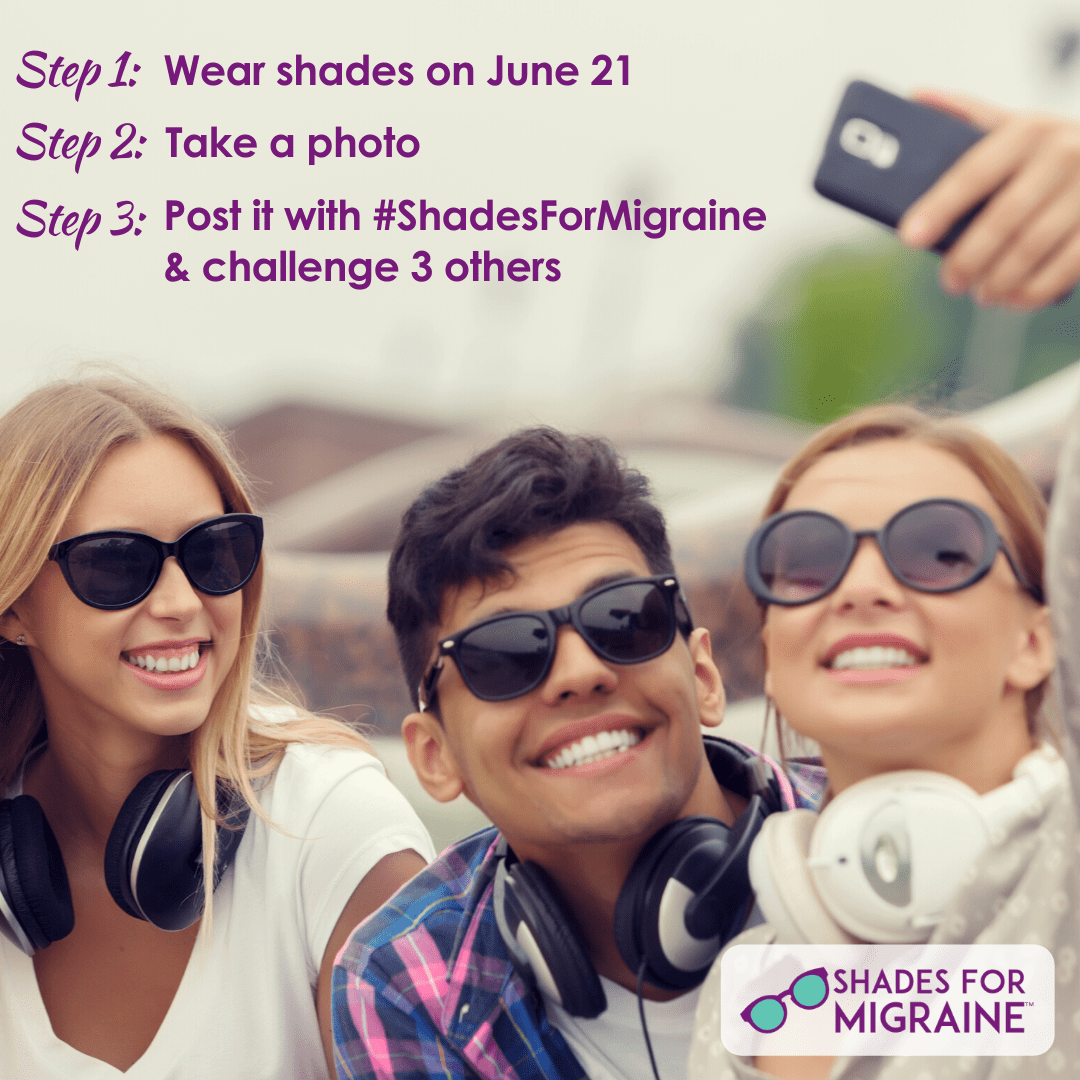Shades for Migraines – Wear Shades, Take A Photo, Post on Social Media to help show support for Migraine Solidarity Day. #ShadesforMigraines #MigraineSolidarityDay #Migraines
Shades for Migraines

This day is held annually on June 21st.
How to participate
Shades for Migraines – @shades4migraine Wear Shades, Take A Photo, Post on Social Media to help show support for Migraine Solidarity Day. #ShadesforMigraines #MigraineSolidarityDay #Migraines Share on XIt is very simple to participate in this holiday. Just 4 steps …
- Put on your shades on June 21st, Migraine Solidarity Day to show you care for people living with migraine disease.
- Take a photo of you in your sunglasses and don’t forget to get your friends, family and coworkers in on the fun.
- Post your photo on social media with the hashtag #ShadesForMigraine and challenge 3 friends to take part too!
- Watch your impact multiply!

In 2017, the Association of Migraine Disorders created Shades for Migraine as a way to create a viral buzz around a disease that affects more than 1 billion people worldwide.
Why Sunglasses?
Sunglasses was chosen because it is an indicator of migraines in a person because of sensitivity to light such as sunlight. Which is a common trigger for most migraine sufferers.
Sunglasses was chosen because it is an indicator of migraines in a person because of sensitivity to light such as sunlight. Which is a common trigger for most migraine sufferers.#ShadesforMigraines #MigraineSolidarityDay #Migraines Share on XMigraine Facts
Migraine Facts #ShadesforMigraines #MigraineSolidarityDay #Migraines Share on XMigraine disease is not just a bad headache.
- Migraine disease is not just a bad headache.
- Migraine is an umbrella term representing a genetic, multi-system neurological disease. Known for its headaches, migraine also affects mood, gastrointestinal function, balance, sleep, facial pain and more.
Migraine is a significant chronic disease.
- More than 4 million people have chronic daily migraine, with at least 15 migraine days per month.
Migraine disproportionately impacts women.
- Almost one-third of women will experience migraine during theirlifetime.
- 75% of all people with migraine are women.
That means I am one of the 25% of men that has migraines.
Migraine erodes quality of life.
- Migraine is the sixth highest cause of years lost due to disease,according to the World Health Organization.
Migraines differ from other types of headaches
Migraine sufferers are adept at recognizing when migraines begin to form. Many people only find relief after spending several hours lying down in pitch-black rooms.
Calling a migraine a headache is somewhat misleading, as migraines produce an assortment of symptoms and may not feature pain at all.
The Mayo Clinic says sinus headaches, which occur with sinus infections or symptoms like congestion and facial pressure, sometimes are mistaken for migraines. But migraines often are much more menacing than sinus headaches. Migraines stand alone because they are often intense and severe and have other symptoms in addition to head pain, states Healthline.
Symptoms associated with migraines include:
· pain behind one eye or ear
· temple pain
· seeing spots or flashing lights
· nausea
· sensitivity to light and/or sound
· temporary vision loss
· vomiting
Changes in brain activity can affect blood flow in the brain and surrounding tissues that contribute to migraine symptoms. That’s what makes migraines more than just severe head pain.
Penn Medicine states that migraines occur in four different phases.
1. Prodome phase:
This pre-headache phase includes painless symptoms that can occur days or hours before the migraine. Mood swings, stiffness in the neck and food cravings are some of these symptoms.
2. Aura phase: A
uras are sensory disturbances that occur before or during a migraine. Auras can affect vision, hearing, touch, or speech.
3. Headache phase:
If pain appears, sufferers are in the headache phase. Pain may range from mild to debilitating. It’s important to note people can have a migraine without head pain. The American Migraine Foundation notes that silent or acephalgic migraine is a type of migraine that can be very alarming. During these types of migraines, one experiences dizzying aura and other visual disturbances and nausea, but no head pain.
4. Postdromal phase:
This is when the migraine pain has subsided. People may feel tired and unwell during this phase.
Migraines generally have triggers. Finding the cause can help sufferers avoid these triggers and tame the severity or frequency of migraines. Allergies, hormonal changes, family history, changes in weather, certain aromas, and lack of sleep can contribute to migraines. Learn more about migraines at Americanmigrainefoundation.org.
The different types of migraines
A migraine is not merely a headache, it’s actually a neurological disease. People may be surprised to learn that there are different types of migraines. The American Migraine Foundation says migraines are typically classified as one of these types.
· Migraine with aura (complicated migraine):
This is a migraine characterized by a series of sensory and visual changes. Aura generally sets in shortly before or during a migraine.
· Migraine without aura (common migraine):
This type of migraine can be challenging to diagnose because symptoms are similar to other types of migraines. However, pulsing or throbbing pain on one side of the head, photophobia, phonophobia, nausea, and vomiting are all classic symptoms of migraine without aura. This type of migraine also lacks the warning phases of other types of migraines.
· Silent migraine:
A silent migraine has the same symptoms of migraine with aura but no head pain. Silent migraines also are called acephalgic migraines or typical aura without headache.
· Hemiplegic migraine:
People who experience this type of migraine usually have weakness on one side of the body with visual aura symptoms. A “pins and needles” sensation or loss of sensation on one side of the body also can occur. This migraine also doesn’t always include severe head pain
Sources:
- Shakes for Migraines ShadesforMigraine.org
- @shadesformigraine (Instagram)
- @shadesformigraine (Facebook)
- American Migraine Foundation AmericanMigraineFoundation.org
- Penn Medicine PennMedicine.org
- Healthline HealthLine.com
Info taken from Shakes For Migraines, American Migraine Foundation and MetroCreative (TF206037 | TF206035).
About the Author
Discover more from Courageous Christian Father
Subscribe to get the latest posts sent to your email.


